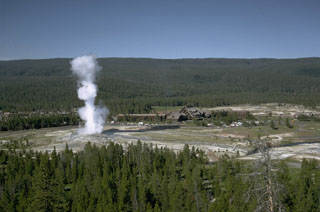Report on Yellowstone (United States) — 17 July-23 July 2024
Smithsonian Institution / US Geological Survey
Weekly Volcanic Activity Report, 17 July-23 July 2024
Managing Editor: Sally Sennert.
Please cite this report as:
Global Volcanism Program, 2024. Report on Yellowstone (United States) (Sennert, S, ed.). Weekly Volcanic Activity Report, 17 July-23 July 2024. Smithsonian Institution and US Geological Survey.
Yellowstone
United States
44.43°N, 110.67°W; summit elev. 2805 m
All times are local (unless otherwise noted)
The Yellowstone Volcano Observatory (YVO) reported that at around 1000 on 23 July a small hydrothermal explosion occurred in Yellowstone’s Biscuit Basin thermal area, located about 3.5 km NW of Old Faithful. The explosion likely originated near Black Diamond Pool and was recorded by visitors that were on the nearby boardwalk. Ejecta from the explosion damaged the boardwalk; no injuries were reported. Biscuit Basin, including the parking lot and boardwalks, were temporary closed for visitor safety. YVO noted that the explosion did not reflect activity within volcanic system, which remained at normal background levels of activity, and was not caused by magma rising towards the surface. Hydrothermal explosions are relatively common in Yellowstone. The Volcano Alert Level remained at Normal (the lowest level on a four-level scale) and the Aviation Color Code remained at Green (the lowest color on a four-color scale).
Geological Summary. The Yellowstone Plateau volcanic field developed through three volcanic cycles spanning two million years that included some of the world's largest known eruptions. Eruption of the over 2,450 km3 Huckleberry Ridge Tuff about 2.1 million years ago created the more than 75-km-long Island Park caldera. The second cycle concluded with the eruption of the Mesa Falls Tuff around 1.3 million years ago, forming the 16-km-wide Henrys Fork caldera at the western end of the first caldera. Activity subsequently shifted to the present Yellowstone Plateau and culminated 640,000 years ago with the eruption of the over 1,000 km3 Lava Creek Tuff and the formation of the present 45 x 85 km caldera. Resurgent doming subsequently occurred at both the NE and SW sides of the caldera and voluminous (1000 km3) intracaldera rhyolitic lava flows were erupted between 150,000 and 70,000 years ago. No magmatic eruptions have occurred since the late Pleistocene, but large hydrothermal events took place near Yellowstone Lake during the Holocene. Yellowstone is presently the site of one of the world's largest hydrothermal systems, including Earth's largest concentration of geysers.

